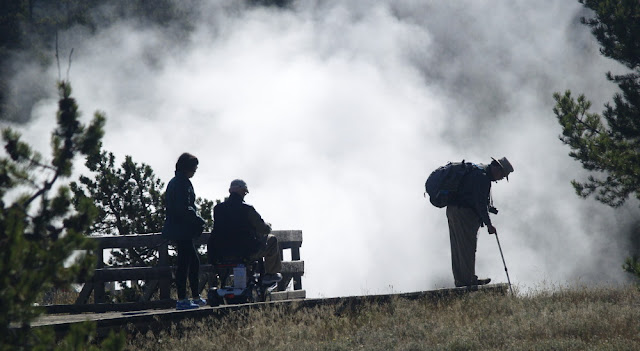 |
| A Yellowstone mud pot bubbles rock into future clay. |
Dear Milana and Nellie,
Today's blog is a bit of a geology lesson, and we're going to start with two elements and a compound. I guess I should define an element:
An element is "each of more than one hundred substances that cannot be . . . broken down into simpler substances." For example, pure silica and pure aluminum are all made of the atoms that bear their name; they are elements.
Water, on he other hand, is not an element, because it is a combination of the elements hydrogen and oxygen. Water is the compound I was talking about.
These two elements and a compound are the primary components of the clay we use for ceramics. And Yellowstone is creating tons of clay. It's taking a while, but the photo at the top of this blog is an example of the creation of clay. The action is probably getting a lot of help from sulfur, which comes from volcanos. (Another word for sulfur is "brimstone," because it's the stone-like substance you find at the brim of a volcano.
Now here is something else you may find interesting. For most of your life you have been walking on aluminum and silica. -- For example, all that sand on the beach? Silica.
Silica and aluminum are very abundant and also very light. They differ from each other by only one proton and one electron. And that little difference means that silica can be transparent, but aluminum is opaque. Silica is an insulator and aluminum conveys electricity. Silica is brittle and aluminum is malleable. (Look up the word, malleable.)
These elements are the pond scum of the earth; they float to the top of the world, and they make continents, which are sometimes referred to as "sial," for silica (si) and alluminum (al). It's because of the abundance that mankind was able to create the first medium to write on (clay tablets) and vessels to hold food and water (pottery). In a way, clay was the foundation for civilization.
The igneous (look up igneous) rocks that are part of continents take a long time to break down into clay, but Yellowstone does it much faster with all the sulfur that's available from this super volcano; sulfur and heat make for a nice acidic brew that turns rock into clay much faster than the weather does.
Enough of a lecture. The rest of this blog is going to be mostly photos of what I saw yesterday. The photos should speak for themselves, but I've added captions anyway. Feel free to ask me questions, if you like.
Also, start looking for errors in my writing. Marilyn found 12 in yesterday's blog. If you had found them, you could have made a bundle. (Well, OK, some spare change.) Maybe you can write to Marilyn and ask her what the errors were. She wouldn't mind hearing from you, and you have her e-mail address.
Love,
Robert
Photos follow.
 |
| The ground at Yellowstone smokes with boiling cauldrons of hot rocks and chemicals. |
 |
| Yellowstone is the land of stinky air and sometimes you're not far from a cloud of steam and gas. |
 |
| I'm not sure what they are photographing, but they sure are enthusiastic. |
 |
| A geyser periodically shoots water into the air. |
 |
| The water bubbling up from this cauldron seems to be crystal clear, but it's loaded with chemicals. |
 |
| Another Yellowstone casualty. |
 |
| Shallow pools of water sometimes look like an abstract painting. |
 |
| These colors are created by mats of bacteria that tolerate the 160+ degree water. |
 |
| I visited a "mud volcano" that bubbled and sputtered out the rock it had dissolved. |
 |
| This pool looks placid, but the water is scalding hot. |
 |
| More colorful bacterial mats. |
 |
| This photo showed me what happens when the bubbles collapse. My eye didn't catch it, but the camera did. |
 |
| For a while I couldn't figure out why the cars weren't moving, and then the reasons plodded by. |





No comments:
Post a Comment
Note: Only a member of this blog may post a comment.